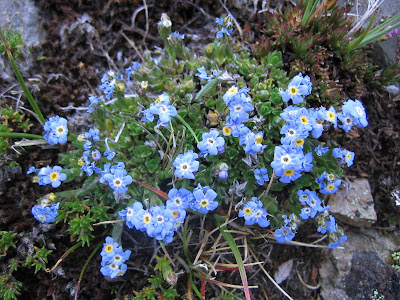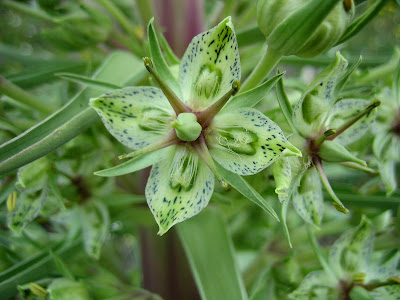
But even more so for Anacondans than for Buttians, the Pintler is their backyard wilderness. Many of the "30" license plates are there to hike, not to party. For all of us, the wilderness, "ah, what a feeling:"

Yeah, it's only a line on a map, but it's a line that (mostly) excludes the motorheads and preserves fragile places of beauty, like this creek tumbling down a steep mountain side:

Here's RTD posing next to a hollow tree where "Banjo" might have lived as a small child:

Banjo was an orphan girl raised by her forest animal friends. Banjo was a sort of alter-ego for my daughter Emily Munday when she was young, and bedtime stories often involved intricately woven tales of Banjo's many adventures. How, here's one of Banjo's friends now, Mulie, peaking through the timber :

Unlike recent years, snow drifts are lasting well into summer, even at lower elevations along the Pintler trails:

Don't eat the pink snow, it's psychotropic. You ask, "How do you know?" Don't:

As you crest Storm Lake Pass, you gain a sweeping view of Goat Flat:

After hiking across the narrow trail on the steep face of Mt Tiny, you're there:

Magic place, Goat Flat, with patterned ground:

And of course goats (or, at least, goat fur):

The main purpose of this trek was to visit Kurt Peak, a vision quest site once used by several indigineous cultures. But in making this quest, I also came to learn that wilderness does not always equal solitude. And of course I could not help but notice the outstanding wildflower display that is gracing the high country this year.
Peak Bagging
After making camp, RTD and I took an easy walk up Mount Tiny. At 9,869 feet, it's not much higher than Goat Flat. From the peak, there is a great view east to Howe, Evans, and Haggin peaks. I find it remarkably comforting and satisfying to look out on familiar areas:

Although only 9,977 feet, Kurt Peak is a kick-ass place to scramble (Sierra Club M3 rating), at least along the ridge from the Goat Flat side. The route follows a jagged ridge that defines the word "craggy." There is lots of exposure along most of the route. A view of the approach from the Goat Flat side. Kurt Peak is on the right, with a smaller false peak in-between, and the Goat Flat take-off point on the left. The saddle between Goat Flat and the first (false) peak is especially challenging to get around, as there are several 10 to 20 foot cliffs:

It's not overly dangerous and can be followed by a non-technical scrambler, but you do want to exercise some precautions. And it definitely calls for strong legs, good balance, and no paralyzing fear of heights/exposure. Here's a short list based on my peak-bagging scrambles, rambles, and (occasionally) shambles:
- Wear good boots with a Vibram-type sole and a pronounced heel. The heel is especially important when descending on snow (see "kicking steps," below), but it provides the grip you need for descending on all sorts of terrain.
- Every step you take is a little scouting foray. Always be prepared to backtrack if the route looks like trouble.
- As sort of a corollary to the previous point, don't be in a hurry. Start early and allow yourself plenty of time before the thunderheads begin to build, as they often do in the mountains on warm afternoons. Watch the sky, and if the anvil clouds begin forming, consider your trek a scouting foray and come back another day.
- Carry a stout hiking staff and maybe an ice axe.
- Feel the geology. The strike and dip will give you a sense of the structural features that make climbing easier.
- Follow the mountain goats. Well, not literally--I'm not suggesting that any human can go where a goat can go. But generally, goats take the easiest route--when you see numerous goat tracks and signs leading one way or another around a ridgeline feature, Oreamnos might be trying to tell you something.
- Look back often. Most of us don't have "photographic memory," but you will recognize your return route when you get to it. That is, if you have turned around so that you have actually seen that view before.
- Know how to kick steps properly on a snowfield, whether traversing, ascending, or descending. Keep your weight over your feet, keep your feet level, face the direction you are going, and use your staff or ice axe as a third leg.
- Test hand holds and ledges before committing your weight to them. Nothing like having a 50-pound goonie come loose as you're pulling yourself up to a ledge.
Don't forget to enjoy the hike! Listen to the pikas cheer you on. Watch the marmot drape its belly over a warm rock. Some of the coolest flowers grow in the nooks and crannies you find as you weave your way along a ridge. Like this one, some species of Primrose I think:
It was good to be on top, enjoy the view, have a snack and a drink, and rest my legs for the return (but not for long; the cumulus were building). Here's the view west (to Warren Peak) from Kurt Peak:
Alpine Wilflowers
Unlike trying to photograph birds or mammals that are constantly either on the move or at long range, it's easy to sneak up on a flower for a close-up. The incredible spring bloom continues, fed by snowdrifts melting in the warm July sun:
Goat Flat is a literal carpet of wildflowers. I felt a little guilty at every step, and tried to walk where I might do the least damage:
Buttercups, including the Mountain Buttercup (Ranunuculus eschscholtzii) dominate much of the tundra, I think perhaps because they are toxic and thus thrive as more edible species are eliminated by marmots and browsers such as goats:
Shooting Stars (Dodecatheon pulchellum) are everywhere in the Alpine meadows this year:
As are Elephantheads (Pedicularis groenlandica):
Four-angled Mountain Heather (Cassiope tetragona) is a little more choosy, forming dense mats here and there (there was also Yellow Mountain Heather (Phyllodoce granduliflora), but I failed to get a good photo]:
The tiny Alpine Forget-me-not (Eritrichium nanum) grows on the tundra, and you'll understand the name if you bend down and take in the incredible fragrance:
Like Forget-me-nots and heather, Moss Campion or Carpet Pink (Silene acaulis) is a cushion plant that helps create its own micro-environment:
Elk Gentian or Showy Green Gentian (Frasera speciosa) looks rather bland at first glance:
But on close inspection you appreciate the "showy" part:
Stonecrop (Sedum sp.) is easy to recognize as a genus, but I haven't figure out the species details:
Out of habit, you expect Alpine wildflowers to be tiny. Then an out-sized Aster (Aster sp.) shows up and defies the pattern:
In the drier woods along the edges of the tundra were Nuttal Violets (Viola nuttalli) and other woodland flowers. I resisted the urge to pluck a handful as a colorul and tasty garnish for my noodles:
I camped just below treeline where I hoped my bivvy sack might not be such a good target for a lightening bolt. The Alpine Larch were in "flower" with their delightful, purplish cones:
People
Small world, the Pintler Wilderness. Hiking in from a popular trailhead for a popular destination, I hardly expected to be alone. Yet I go to the wilderness for solitude, and at first glance often resent seeing others. But that feeling quickly disappears (well, usually) after meeting and talking with them.
First came the wilderness ranger (Lucinda Jann?) as I was setting up camp. We chatted a bit, played the name game, and came up with shared acquaintences such as Paul Olson. Now retired, he was still working for the FS when I met him the first time, also on a Goat Flats hike.
Then there were the two old guys (for me to say that, one must appear to be 65+) I met on Mount Tiny. We chatted a bit, played the name game, and came to realize that one fellow's mother, a Dunn, was also from Walkerville.
Hiking to and from Kurt Peak, I passed a tent set up in a last fringe of trees below the ridge. Turns out it was Jim Costello and Mary Costello of the Rock Creek Alliance in Idaho. They are fighting the stupid Rock Creek Mine, which the Forest Service wants to permit for the Cabinet Wilderness. Jim and Mary and I knew many folks in common, including Bruce Farling of Montana Trout Unlimited, Chris Brick of the Clarkfork Coalition, and Jim Kuipers, a technical consultant that also works for the Clark Fork River Technical Assistance Committe.
Small world, the wilderness.

















1 comment:
Stunning wildflower collection. I enjoyed every one. Thanks for sharing!
Post a Comment